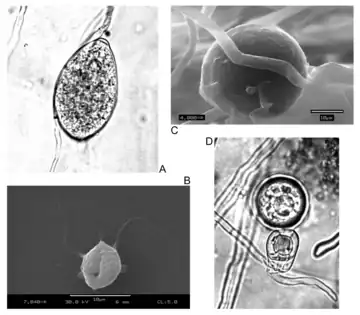Pythiaceae
Pythiaceae is a family of water moulds. The family includes serious plant and animal pathogens in the genus Pythium. The family was circumscribed by German mycologist Joseph Schröter in 1893.
| Pythiaceae | |
|---|---|
 | |
| Water mould - Phytophthora forms: A: Sporangia. B: Zoospore. C: Chlamydospore. D: Oospore | |
| Scientific classification | |
| Kingdom: | Chromista |
| Phylum: | Oomycota |
| Order: | Peronosporales |
| Family: | Pythiaceae J. Schröt., 1893 |
| Type genus | |
| Pythium Pringsh., 1858 | |
| Genera | |
| |
Lifecycle
- Live on land (terrestrial), and in water (aquatic), and a combination of the two, (amphibious)
- Live as deadly parasites, causing some serious plant and animal diseases when terrestrial.
- The diploid (2N) life stage predominates, with a short haplophase initiated during sexual reproduction as well as asexual reproduction (homothallism predominates in the Family) to fuse gametes.
Reproduction
The sporangia may germinate via a germ tube or by release of motile zoospores, depending on the species and the environmental conditions.
Economic importance
Some Pythium species cause "damping off" diseases in young plants (seedlings).
References
- C.J. Alexopolous, Charles W. Mims, M. Blackwell et al., Introductory Mycology, 4th ed. (John Wiley and Sons, Hoboken NJ, 2004) ISBN 0-471-52229-5
This article is issued from Wikipedia. The text is licensed under Creative Commons - Attribution - Sharealike. Additional terms may apply for the media files.